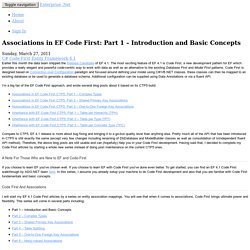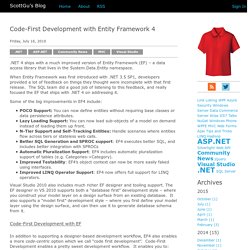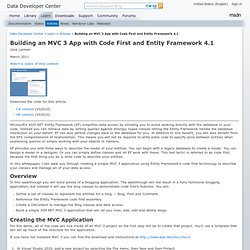

ASP.net / C# ASP.NET MVC. MVC Architecture. Entity framework. Sql server. Code first. Associations in EF Code First: Part 1 – Introduction and Basic Concepts - Enterprise .Net. Earlier this month the data team shipped the Release Candidate of EF 4.1.

The most exciting feature of EF 4.1 is Code First, a new development pattern for EF which provides a really elegant and powerful code-centric way to work with data as well as an alternative to the existing Database First and Model First patterns. Code First is designed based on Convention over Configuration paradigm and focused around defining your model using C#/VB.NET classes, these classes can then be mapped to an existing database or be used to generate a database schema. Additional configuration can be supplied using Data Annotations or via a fluent API. I’m a big fan of the EF Code First approach, and wrote several blog posts about it based on its CTP5 build: Compare to CTP5, EF 4.1 release is more about bug fixing and bringing it to a go-live quality level than anything else.
A Note For Those Who are New to EF and Code-First If you choose to learn EF you've chosen well. Code First And Associations. Code-First Development with Entity Framework 4. .NET 4 ships with a much improved version of Entity Framework (EF) – a data access library that lives in the System.Data.Entity namespace.

When Entity Framework was first introduced with .NET 3.5 SP1, developers provided a lot of feedback on things they thought were incomplete with that first release. The SQL team did a good job of listening to this feedback, and really focused the EF that ships with .NET 4 on addressing it. Some of the big improvements in EF4 include: POCO Support: You can now define entities without requiring base classes or data persistence attributes.Lazy Loading Support: You can now load sub-objects of a model on demand instead of loading them up front.N-Tier Support and Self-Tracking Entities: Handle scenarios where entities flow across tiers or stateless web calls.Better SQL Generation and SPROC support: EF4 executes better SQL, and includes better integration with SPROCsAutomatic Pluralization Support: EF4 includes automatic pluralization support of tables (e.g.
Building an MVC 3 App with Code First and Entity Framework 4.1. Julie Lerman March 2011 Watch a video of this content Download the code for this article: Microsoft’s ADO.NET Entity Framework (EF) simplifies data access by allowing you to avoid working directly with the database in your code.

Instead you can retrieve data by writing queries against strongly typed classes letting the Entity Framework handle the database interaction on your behalf. EF provides you with three ways to describe the model of your entities. In this whitepaper, I will walk you through creating a simple MVC 3 application using Entity Framework’s code first technology to describe your classes and manage all of your data access. Overview In this walkthrough you will build pieces of a blogging application. Creating the MVC Application For this demo, all of the code will live inside of an MVC 3 project so the first step will be to create that project. If you have not installed MVC 3 you can find the download and instructions at Figure 1: Creating a new MVC 3 Project Summary.
Getting Started with EF 6 using MVC 5.